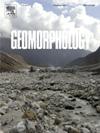爱尔兰西北部罗卡尔海槽(东北大西洋)陆坡上的轮廓岩分布:成因与演化
IF 3.1
2区 地球科学
Q2 GEOGRAPHY, PHYSICAL
引用次数: 0
摘要
大陆斜坡通常受到洋流的影响,形成等高岩体系,特别是在海底峡谷不是很丰富的地区。虽然在不同的环境中已经发现了等高岩,但由于直接的海洋学观测有限,尚不清楚近底环流如何控制等高岩系统中沉积物的沉积和侵蚀以及形成斜坡。位于爱尔兰西北部近海的罗卡尔海槽东部的大陆斜坡被大量的灰泥漂流物所控制,这些漂流物与轮廓岩阶地有着遗传上的联系。梯田与灰泥流道一般同步生长,形成梯田-灰泥流道体系(T-D体系)。这项研究的重点是通过结合地球物理、沉积学和海洋学观测的多学科方法发展T-D系统和海洋学过程的影响。在北大西洋东部水(ENAW)的影响下,T-D系统在水深500-1500 m的上、中斜坡发育。它们开始形成于晚渐新世。直接测量表明,强大的沿坡底流(高达50厘米/秒)和破碎的内波控制着T-D系统的发展。内波活动导致在T-D系统上方形成高浊度的星云层。所观察到的等高岩系的扩展受下坡重力作用的限制,海底峡谷限制了其侧向扩展,而下坡则主要受物质消耗作用的限制。这项研究提供了一个更好的理解的条件下,底流控制大陆斜坡的形态在世界范围内。本文章由计算机程序翻译,如有差异,请以英文原文为准。
Contourite distribution on the continental slope off NW Ireland, Rockall Trough (NE Atlantic Ocean): genesis and evolution
Continental slopes are commonly shaped by ocean currents, forming contourite systems, especially in areas where submarine canyons are not very abundant. Although contourites have been identified in different environments, it is still unclear how near bottom circulation controls the deposition and erosion of sediment in contourite systems and shapes the slope due to the limited direct oceanographic observations. The continental slope located on the eastern Rockall Trough offshore NW Ireland is dominated by numerous plastered drifts, which are genetically linked with contourite terraces. Terraces and plastered drifts generally grow synchronously to form terrace-plastered drift systems (T-D system). This research focuses on the development of T-D systems and the effects of oceanographic processes through a multidisciplinary approach that combines geophysical, sedimentological and oceanographic observations. T-D systems develop on the upper and middle slopes at 500–1500 m water depths under the influence of the Eastern North Atlantic Water (ENAW). They started to form during the Late Oligocene. Direct measurements show that strong along-slope bottom currents (up to 50 cm/s) and breaking internal waves control the development of T-D systems. Internal wave activity causes the formation of high-turbidity nepheloid layers above the T-D systems. The extension of the observed contourite systems is confined by downslope gravitational processes, with submarine canyons limiting their lateral extension and mass-wasting processes dominating the lower slope. This study provides a better understanding of the conditions under which bottom currents control the morphology of continental slopes worldwide.
求助全文
通过发布文献求助,成功后即可免费获取论文全文。
去求助
来源期刊

Geomorphology
地学-地球科学综合
CiteScore
8.00
自引率
10.30%
发文量
309
审稿时长
3.4 months
期刊介绍:
Our journal''s scope includes geomorphic themes of: tectonics and regional structure; glacial processes and landforms; fluvial sequences, Quaternary environmental change and dating; fluvial processes and landforms; mass movement, slopes and periglacial processes; hillslopes and soil erosion; weathering, karst and soils; aeolian processes and landforms, coastal dunes and arid environments; coastal and marine processes, estuaries and lakes; modelling, theoretical and quantitative geomorphology; DEM, GIS and remote sensing methods and applications; hazards, applied and planetary geomorphology; and volcanics.
 求助内容:
求助内容: 应助结果提醒方式:
应助结果提醒方式:


